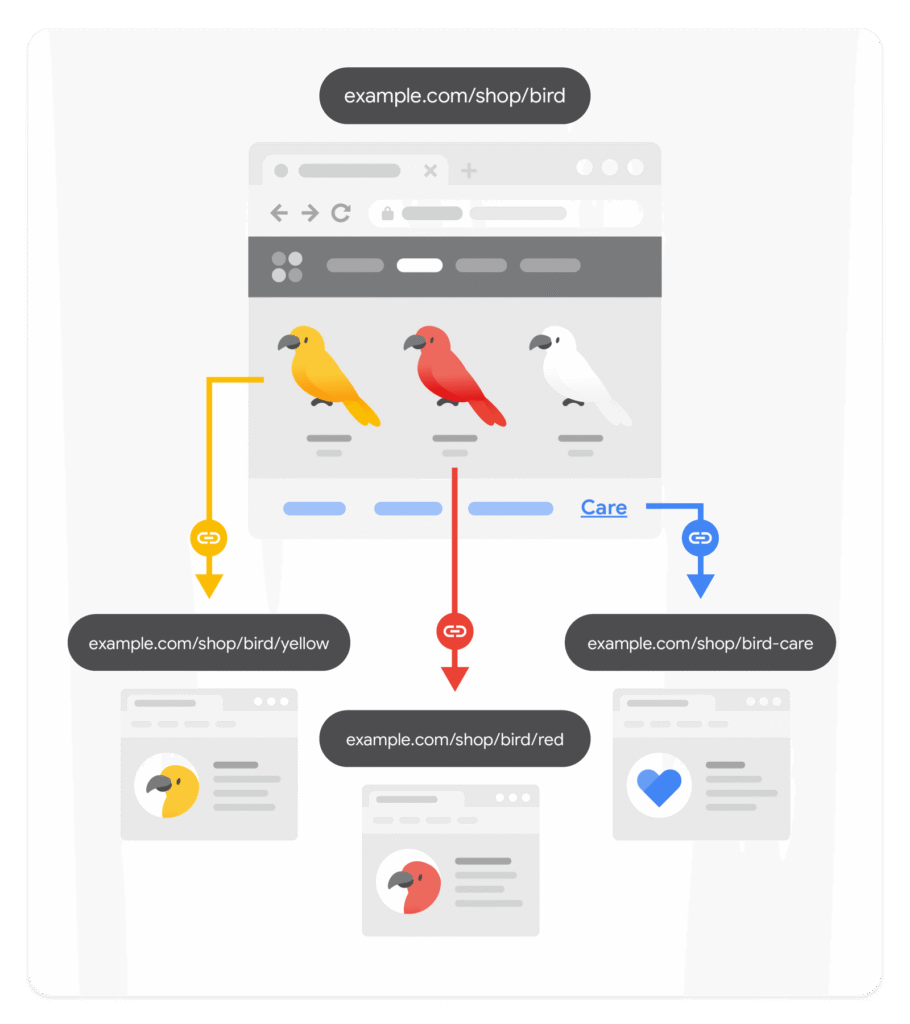Want to rank your pages higher on Google without burning through your budget or motivation? The key often lies even before writing a single line: in choosing your SEO keywords.
Well-chosen, they attract qualified traffic, speak your customers’ language, and improve your conversions. In this ultra-practical guide, we move from intuition to process: keyword analysis, SERP reading, scoring, page mapping, optimization, and iteration.
Here are the steps to follow:
1) Start with Search Intent (Always)
Before even thinking about an SEO keyword list, ask yourself: what real need does the query address? A topic can cover very different intents. A user typing “how to configure GA4” is looking for a step-by-step guide (informational intent).
Another user typing “best SEO agency Paris” wants to compare providers (commercial intent).
“SEO audit price” indicates a more transactional intent: the expected page is a landing page that explains the offer, value, and pricing (or at least the costing method).
Finally, “Donutz Digital” is a navigational query.
Why does this distinction change everything? Because educational content will never consistently rank for a query where Google prioritizes product pages, and vice versa. The winning approach is to open Google’s top 10 for each SEO keyword and observe what the algorithm deems relevant: formats, angles, depth, authority signals. Then, associate a clear intent with each query in your spreadsheet: I (informational), C (comparative), T (transactional), N (navigational). This simple column avoids weeks of misdirected production.
2) Build your Themes from Customer Questions
Your editorial backlog shouldn’t stem from isolated brainstorming, but from real-world questions. Listen to support, sales, comments on your social media, and discussions in communities where your prospects engage. Objections often arise: “how much does it cost?”, “is it compatible with my CRM?”, “how long until I see results?”
Each of these is a topic. Then, categorize these topics into thematic silos. For a sports e-commerce site, for example, you’ll find “running”, “trail”, “nutrition”, and “recovery”. For a SaaS, “onboarding”, “security”, “pricing”, and “integrations”.
Add a persona layer. A beginner doesn’t have the same expectations as a power user or a professional buyer. By linking each silo to a specific persona, you clarify the tone, level of detail, and angle, and you avoid the trap of lukewarm content meant to appeal to “everyone”.
3) Combine the Tools
No single tool holds the absolute truth. Google Search Console provides the actual queries that are already triggering your impressions: it’s gold you had under your feet. To expand and assess difficulty, Ahrefs or Semrush can be useful. Add AnswerThePublic to capture the natural language behind “People Also Ask”, and consider Google, YouTube, or Amazon’s auto-completion suggestions to grasp real-world phrasing.
The right approach is to cross-reference potential (volume, trend, CPC indicative of business intent) with feasibility (SERP difficulty, domain authority, required content level). When two expressions are very similar (“SEO keywords”, “keywords in SEO”, “keyword SEO”), group them into a cluster: a structured page can perform for the entire group, especially if you cover the topic in depth.
4) Mix Head, Mid, Long-Tail… and Local
Not all keywords are alike. Head terms like “SEO” or “email marketing” have high volume and fierce competition; they serve as long-term pillars but shouldn’t monopolize your efforts.
Mid-tail keywords (“e-commerce SEO strategy”, “GA4 dashboard”) are more targeted and achievable for sites with intermediate authority.
The long tail (“B2B editorial calendar example”, “product schema markup guide”) offers clear intents and conversion rates you don’t want to leave to the competition.
Finally, the local angle (“SEO agency Lyon”, “bike shop Paris 11”) remains crucial if you have a geographical presence.
The reasonable strategy for a site that wants to grow without burning its budget: aim for quick wins on the long tail, build solid mid-tail clusters around pillar pages, and work on a few structuring head terms with a link-building plan and internal linking that irrigates the entire ecosystem. Yes, your SEO keywords must reflect this pyramid, not the other way around.
5) Analyze the SERP like a Detective
Open the SERP and read it. What formats dominate? Listicles, guides, comparisons, videos, product pages? What features are displayed: Featured Snippet, People Also Ask, local pack, image carousels, YouTube videos? What depth do the leading pages provide: concrete examples, up-to-date sources, proof of experience? Are E-E-A-T elements (expertise, experience, authority, trustworthiness) visible: identified authors, legal mentions, studies, references? What about performance: speed, mobile UX, title structure?
From this reading emerge angle opportunities. A majority of outdated content? Update the figures and show your method. Few concrete examples? Add verifiable mini-cases. No FAQ? That’s an opportunity, especially if you implement the FAQPage schema. Keyword analysis isn’t just a series of columns: it’s an investigation into “what Google already rewards” and “what’s still missing”.
6) Prioritize with a Simple Scoring System
Take your candidate SEO keywords and score them on three criteria: Potential, Feasibility, Business Relevance. Potential combines volume and commercial value. Feasibility considers the perceived SERP difficulty and your current strengths (authority, content assets, exploitable internal links). Relevance measures alignment with your personas and your offering: does this traffic have a reasonable chance of converting?
A formula like Score = (Potential × 2) + Feasibility + Relevance does the job very well. The important thing isn’t sophistication, but comparability and the ability to make decisions. You’ll get a shortlist that separates topics “deployable within 30 days” from “big bets” to work on over the semester. In meetings, this score helps everyone agree and streamlines decisions, especially when the temptation of “we want the highest-volume keyword” rears its head.
7) Map SEO Keywords and Pages to Avoid Cannibalization
Each cluster must point to an identified target page. We generally distinguish between pillar pages (comprehensive guides, linking hubs), satellite pages (sub-topics, detailed FAQs, case studies), and business pages (products, services, BOFU landing pages). Cannibalization occurs when multiple pages compete for the same query: Google hesitates, and you lose visibility. A clean mapping (“main SEO keyword, intent, target page, status, internal links to create”) is your best safeguard.
Again, think about the user journey. A pillar article on “SEO keywords” can link to satellite pages like “keyword analysis tools”, “scoring method”, “avoiding cannibalization”, and to business pages like “SEO audit” or “editorial support”. Internal linking isn’t just for the robot: it guides the reader to where your value grows.
8) Optimize your Pages: On-Page, Technical, and Internal Linking
Place your SEO keywords in the right places without overdoing density: Title, H1, introduction (within the first 100 to 200 words), subheadings, image alt attributes, meta description, and short URL. In the body, naturally vary phrasing and answer the questions that the SERP highlights. Add FAQs if they help resolve a legitimate doubt.
Internal linking is an underestimated accelerator. Contextual links from pages already receiving traffic will help your new pages emerge. Technically, keep an eye on Core Web Vitals, accessibility (hierarchical headings, contrasts, text alternatives), and relevant structured data (Article, FAQPage, Product, Organization…). All of this doesn’t replace editorial quality, but it makes it fully exploitable.

9) Measure, Learn, Iterate
After going live, Search Console becomes your dashboard. Monitor the evolution of impressions, the average position of target queries, and CTR. Within 30 to 60 days, adjust without rewriting everything: a clearer Title, a more engaging introduction, an enriched section, an added FAQ, a relevant internal link from an old but popular article.
Over the months, consolidate your pillar pages with figures, updated screenshots, or even an explanatory video. This continuous optimization cycle transforms SEO performance into an asset rather than a “one-off success”.
To get started or strengthen your game, keep the Google Search Central SEO guide handy.
Go further with Donutz Digital
If you want an external perspective and results, our SEO audit lays bare your structure, SEO keywords, content, linking, and technical performance, then proposes a prioritized action plan. Browse our SEO Agency page to see how we work, and take a look at our Social Ads Agency if you want to support SEO with well-crafted paid campaigns.
FAQ
How many Keywords to Target per Page?
Keep one main SEO keyword and a cluster of a few close variants. What matters isn’t quantity but alignment with intent and depth of coverage. A good page addresses the topic, not a list of occurrences.
Does SEO Keyword Density Still Have an Impact?
Not as a magic percentage. Place your SEO keywords in strategic locations (Title, H1, intro, subheadings, alt) and focus on providing the best possible answer. Satisfying user intent weighs much more heavily than arithmetic.
Is the Long Tail Worth the Time Invested?
Yes, because it often carries a clear intent close to conversion. Even with modest volumes, the sum of these pages creates a stable and qualified traffic base, less dependent on competitive fluctuations.
How Often should I Update My Content?
Pillar pages benefit from being refreshed every 3 to 6 months: figures, screenshots, FAQs, examples. For the rest, let Search Console guide you: when positions decline or CTR remains low, intervene.
What Free Tools for Initial Keyword Analysis?
Search Console for your real data, Keyword Planner to estimate the potential of your SEO keywords.







